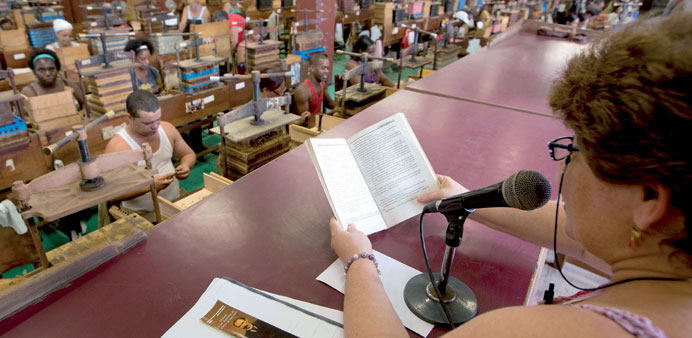By Isaac Risco
It’s very hot. People speak to each other loudly, practically shouting, because that’s the way they do it. There is a sharp smell of fresh tobacco in this horseshoe-shaped factory.
It is shortly before 10 in the morning and at the La Corona cigar factory, not far from Havana’s Revolution Plaza, workers are getting ready to begin their daily shift.
It is also the start of the workday for Odalys Lara, 47; she walks slowly to the front of the room, saying good morning to the tobacco “twisters” as they are known, holding a sheaf of papers and books under her arm.
It won’t be long before Lara will sit on a large platform from where she can look down at the workers in the galley, as Cubans refer to the tobacco factory room. There is a microphone in front of her.
As she begins Lara reads a few short instructions from management, then she wishes Anett, whose birthday it is, a happy birthday, and then she begins to read a book. It’s a novel called City in Panic by Cuban author Modesto Caballero.
Lara is “a tobacco factory reader”. It is a profession unique to Cuba that has, since December 2012 been designated as part of the country’s national cultural heritage.
There are over 100 active “readers” in all of Cuba, and Cubans are seeking to have Unesco declare it a part of intangible world heritage as well because it is such an important long-standing cultural tradition.
The reading tradition began in the 19th century, says Lara, who has been a “reader” for the past 18 years. At that time Cuba was still a Spanish colony and journalist Saturnino Martinez, in 1865, launched a workers’ paper called La Aurora (Dawn).
It was aimed at the proletarian masses and it occurred to Martinez to send somebody to read the newspaper to workers at a tobacco factory in Havana.
“He read it without a microphone, standing on a box,” said Lara. Originally, the practice of reading out loud to people unable to get their hands on books or unable to read at all, began in Cuba’s prisons. It was meant to make prisoners’ lives a little easier to bear.
That is why the rooms where tobacco workers are gathered are called galleys, “galeras” in Spanish, because in Cuba the term applies to prisons. Lara explained how the profession of reader resurfaced in the 20th century, following the Cuban revolution, and it came back “with renewed strength”.
“The reader’s profession, was and is sacred,” wrote Cuban ethnologist and poet Miguel Barnet in an article in the official newspaper Granma last December. The material read in tobacco factories is broad sweeping. The reader reads from books by modern and classic authors and also from Granma and the other state-run news organ, Rebellious Youth.
Works by Shakespeare, Dumas and Emily Bronte’s ‘Wuthering Heights’ are some of the fiction Lara recalls having shared with tobacco workers. She has also read many novels by Colombian Nobel Prize laureate Gabriel Garcia Marquez, including One Hundred Years of Solitude and No One Writes to the Colonel’. Garcia Marquez is very popular and Lara thinks she may have read practically all his books.
Lara explained that workers propose books, and a reading committee makes the final decision on them. “Nowadays they really go for police thrillers,” she said. Lara has also read many books by Leonardo Padura, a popular current Cuban writer. She is sad that she has been unable to find one of his books, The Man Who Loved Dogs. Local bookshops have run out of it.
There are about 360 workers in the La Corona factory. They listen to the reader whose voice emerges from speakers on the walls.
Above the sound of the industrial fans blowing to make workers feel less hot, the lilting voice of the reader can be heard. “(Having a reader) is something extremely necessary for us ‘twisters’,” said Yamile Piz, who is 40 and has worked at La Corona for 20 years.
Piz is an artisan. She patiently rolls the famous Cuban cigars. Each cigar must be twisted carefully. There are high quality standards to meet. The workers store the cigars they produce and measure each day.
Workers can produce 80, 100 or up to 135 cigars per day, depending on the type. “If it were not for the reader we would not be informed,” says Piz. “If it were up to me I would have her read all day,” chimed in another worker, who gave only by her first name Inesita, and who is 37.
Lara reads in half-hour stints, three times per day. She divides novels up into passages when the time is not enough. In this fashion Lara was able to work her way through a 400-page masterpiece by Cuban writer Jose Lezama Lima, Paradise.
“It took me nearly five months,” she recalled, noting that only Les Miserables by Victor Hugo, took her longer to read.
According to the poet Miguel Barnet, some cigars have been given names inspired by famous literary works. For example Romeo and Juliet and Montecristo come from The Count of Monte Cristo by Alexandre Dumas.
“I was a radio announcer and I found out about a contest to become cigar factory reader,” Lara said.
To enter La Corona factory as a reader she competed against two men. She read for 21 days and so did her two adversaries and finally the workers chose her. Workers always have the final word on who stays as reader. – DPA

Employees at the La Corona cigar factory in Cuba listen to their ‘reader’.


